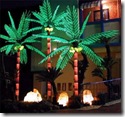The history of t he LED (light emitting diodes) dates back to 1907. However, the most notable discovery was made in 1962 by Nick Holonyak Jr., while working at General Electric Company. He developed the first practical visible-spectrum (red) LED. 1972 brought the first yellow, and much brighter red-orange LEDs. Shuji Nakamura of Japan accepted the Millennium Technology Prize in 2006 for the white LED.
he LED (light emitting diodes) dates back to 1907. However, the most notable discovery was made in 1962 by Nick Holonyak Jr., while working at General Electric Company. He developed the first practical visible-spectrum (red) LED. 1972 brought the first yellow, and much brighter red-orange LEDs. Shuji Nakamura of Japan accepted the Millennium Technology Prize in 2006 for the white LED.
The first practical use of LEDs came in the form of digital indicators on laboratory equipment and later on household appliances. As technology increased, LEDs gained the capacity of illumination. 
There are many remarkable benefits in LED lighting. The lifetime of an LED can extend upwards of 100,000 hours, which is roughly 20 times the expectancy of the best household light bulb (5000 hours). That is twice as long as the best fluorescent lamps (cold cathode CFLs are rated at about 50,000 hours). The traditional incandescent light bulb makes more heat than anything else. Almost all of the energy used by LEDs is converted to light, rather than heat.
LEDs are co mpletely safe to use, and dispose. CFLs (Compact Florescent Lights) contain mercury and other highly toxic substances.
mpletely safe to use, and dispose. CFLs (Compact Florescent Lights) contain mercury and other highly toxic substances.
Now that you know the history and benefits of LEDs you can appreciate the initial investment, and long term savings. If you are observant, you will find many items utilizing LED technology, such as home adornments, for inside and out.


No comments:
Post a Comment